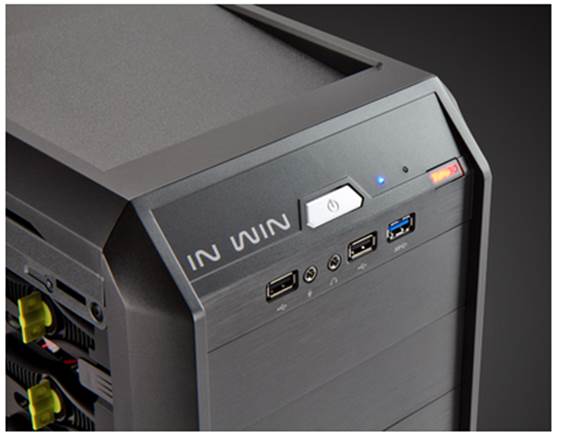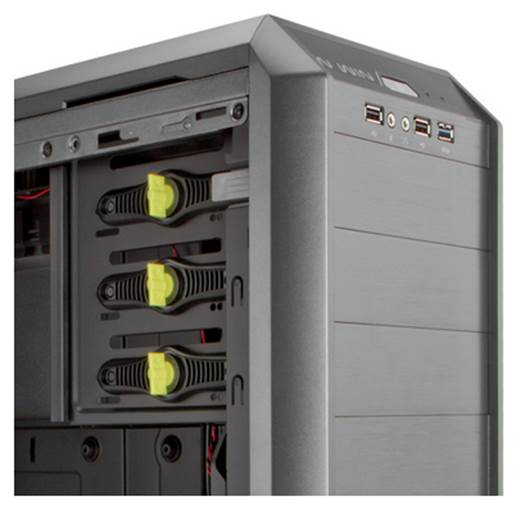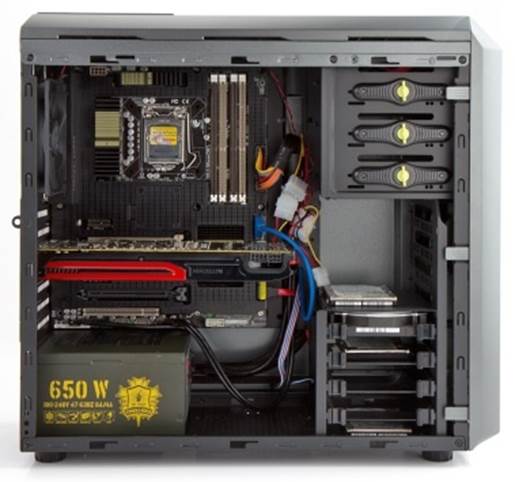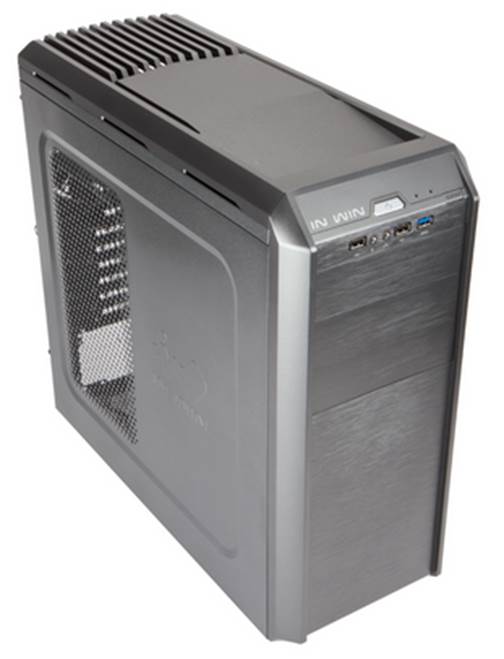In-Win’s toned down budget chassis
hits many of the right spots
In-Win’s retail presence is strongly marked
by cases that range from outlandish to out of this world in design, so its new
G7 chassis is comparatively minimalist. There’s far less bulky plastic and mesh
sections than tends to be the norm, with more smooth and flat areas in their
places.
The color scheme on the grey sample is a
little odd, though, as the plastic and metal bits are noticeably mismatched.
However, the brushed aluminum effect on the front is convincing and a nice
touch. Indeed, the front panel is impressive for a $84 case, its solitary U58 3
port has an internal header, and a sloped section on the roof houses a hot-swap
bay for hard drives and S50-s. There's even some rudimentary tan control, as
users can choose between two speeds using the Tuba button, which fights up red
to indicate the faster speed. The other usual USB and audio connections are
present, but there's no reset button.

I/O
port with LED fan speed controller
The case is certainly light but build
quality is nevertheless mostly up to scratch. We materials and edges are well machined,
and the side panels are nice and solid when they're affixed too. The plastic on
the tool and front sections bends and CIBBKS a little under pressure, however,
and the plastic feet fail to provide the case with any real grip.
The two bundled 120mm fans sit in the front
intake and rear exhaust position, and up to five more can be fitted, although
no larger fan sizes are supported. Water-coolers are also limited to 120mm
radiator solutions or external ones - connected via the pair of tubing holes on
the rear.
A detachable dust filter is supplied for
the front fan, while thin but fiddly material protects the PSU intake and lower
fan mount. There’s no filters for the side mounts of roof one, however, which
could prove slightly problematic in the long run due to the ventilated section
on the roof.

Tool-free
design for ODD & HDD
“The case is certainly light but
build quality is mostly up to scratch”
The two side panels use thumbscrew to
attach, and not needing tools is a theme throughout the case. Pre-built
motherboard mounts as well as tool free dips for 3.5” drives and the three
optical drive bays (SSDs and the PSU still require screws) demonstrate this
clearly.
Installing optical drives requires the
front panel to be clipped out, but is simple once that's done. The seven
internal drive trays are designed to clip 3.5” hard drives into place, which
they mostly do well, although occasionally the pins will be pushed slightly out
of place. Meanwhile, the top three drive bays can be removed to increase airflow
from the front fans, and there's an extra SSO mount beneath the drive cage on
the floor of the case.
One thing that's always nice to see is the
large cutout on the motherboard tray, which will aid the installation of large
CPU coolers that require hefty back plates. Anti-vibration rubber is found
surrounding the pins that hold 3.5” drives in place, but sadly there's no such
material around the PSU area. The expansion slot covers are also disappointing
in that they’re not reusable, but this is a minor niggle.

Inside
In-Win G7
There’s a surprising amount of room behind
the motherboard tray for stashing your cabling, which the extruded side panel
further increases. The indented cable channel is helpful for keeping the bulky
power cables out of the way, and the space beneath the motherboard tray means
it’s easy to get plenty of cables beneath it Sadly. There’s no designated hole
for the EPS12V CPU connector, but at least the fan controller comes wired to
the bundled fans out of the box.
With the case fans on minimum speed,
temperatures registered aren’t too great. The CPU in particular gets fairly
toasty. The fans are nearly impossible to hear at this speed, but noise from
your other hardware is easy to pick out thanks to the meshed side panel and
thin materials.

In-Win
G7 Black Windowed Mid-Tower Case
Switching to Turbo mode adds to the overall
noise as the fans then begin to emit a distinct humming sound. However, there
are much better temperatures in this state, so overclockers in particular would
want to utilize this functionality. The CPU temperature improvement is greater
than the GPU one, which is most likely a result of the restricted airflow
around the front intake fan thanks to the solid front panel.
We’re happy to report that, taken as a
whole, the G7 is evidently a better chassis than many of In-Win's previous
efforts. It has a really great feature set and is nice and easy to work with
too. If you’re keen on it’s design, then the price means that it's unlikely to
let you down. It does, however, face stiff competition from another excellent
budget case, the Xigmatek Midgard II, which has more refined looks and an
better set of features for the same price.